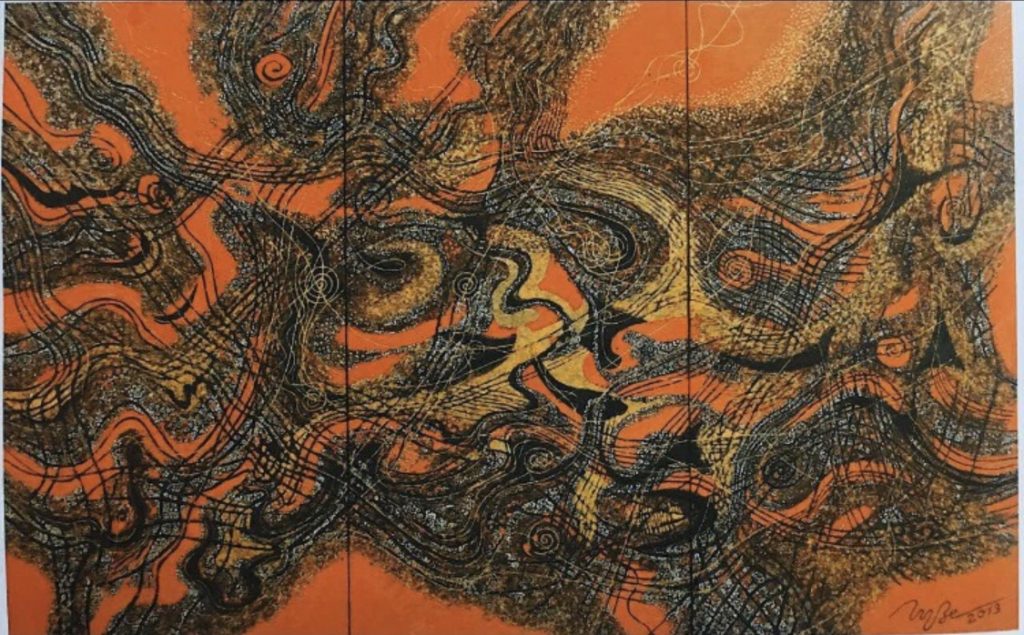Truong Bé: A Quest For The Absolute
Just exactly what do you know about a person? His life?
It is simply what you find out about the world: nothing. The artist, however, offords us (at our own risk and peril) an interpretation of the world, hence a look at himself (“himself” in relation to the world; “himself” as an artist).
Trương Bé is a great artist for the obvious reason that he is a true man who has been able to embody the history of his country even thought he refrains from doing so. Behind his candid and alluring smile and beyond his stalwart posture a strong character is revealed. Some people view solid appearance as something almost akin to a threat.

For me personally, it is sine qua non for bringing to light a genuine talent that I find amidst Vietnamese painting production when it was at its peak. In dealing with lacquer, Trương Bé is Nguyễn Gia Trí’s equal.
In his domain, namely art, he proves to be a happy man and he takes pride in this. His pride bears witness to his happiness and his happiness ennobles his pride. Those who know Vietnam will rightly indentify in him not only this pride tinted with a touch of rudeness inherent in the men of Quãng Trị (where he was born) but also the happiness tinted with some sadness characterizing the inhabitants of Hue (where he has been painting and teaching for a very long time now).
Pride and sadness are the concepts that Vietnamese has adopted for its own sake all throught its history. Far from being haughtiness, Vietnamese sadness does not consist in tears but in a look at times blurred and drownted by a gently repressed broad smile.
Who is more Vietnamese than Trương Bé? Nobody is. Some orthers are but differently. In this aspect, to be sure. He is second to none. To contemplate one of Trương Bé’s works is to start out on a poetic search for the perfect teachnique. Each of his works deserves close scrutiny and calls for an adherence to his internal world.
His demand is total and puts us in mind of Y Lan who died in 1117:
Being is non-being, non-being is being
Y Lan – Being and non-being
Non-being is being, being is non-being
He who does not cling to anything
Is the only one capable of living in perpect harmony with the Absolute.
Chiefly when he expresses himself by means of lacquer (where painting on silk is concerned, lacquer is one of the major contributions of Vietnamese painting art to the world’s one), Trương Bé puts forth a language which is non-verbal yet replete with sounds, a vision which is void of images yet resplendent with colours.
Trương Bé has set his mind on dismantling the world, not to build it anew but to bolster it up. He illustrates this “impermanece of the world” mentioned by Nguyễn Gia Thiều.
Countless people have gone through tribulations and trials!
Nguyễn Gia Thiều (1741 – 1798).
They still retain their human forms; their hearts, however, are dead.
No wonder that the moment he is born, a human being cries to welcome life!
He has been able to portray the spirits of yore with a profution of orange and gold where the lines craving for infinity are held back by unobtainable immortality.
Conscious of this paradox, the painter never ceases giving preference to extremely large formats.
We encounter here the quest of a lone but not isolated man, a passionate soul that has managed to subdue passion.
In witnessing this poetic quest so happily ended, how can we ever miss thinking of Nguyễn Trãi?
Does it really matter if a nobleman is clad in slovenly clothes beneath his dignity?
Nguyễn Trãi (1380 – 1442) – Point of View
All that we have to do is follow the path of the sages of yore
With a cup of tea perfumed with the scent of apricot flowers
I wake up at night to gaze at the moon
During springtime I read and punctuate my books
Careers involving honour bring nothing but anguish and humiliation
In a foolish secluded life there lies liberty
Of my peers a great many are gone
Like paulownia leaves scattered when autumn comes to a close.
The pride of Hanoi, the strength of Quãng Trị, the nobility of Hue and the sweetness of Budapest, all those stages and landmarks have successfully come to make a road a highway.
Jean-François Hubert